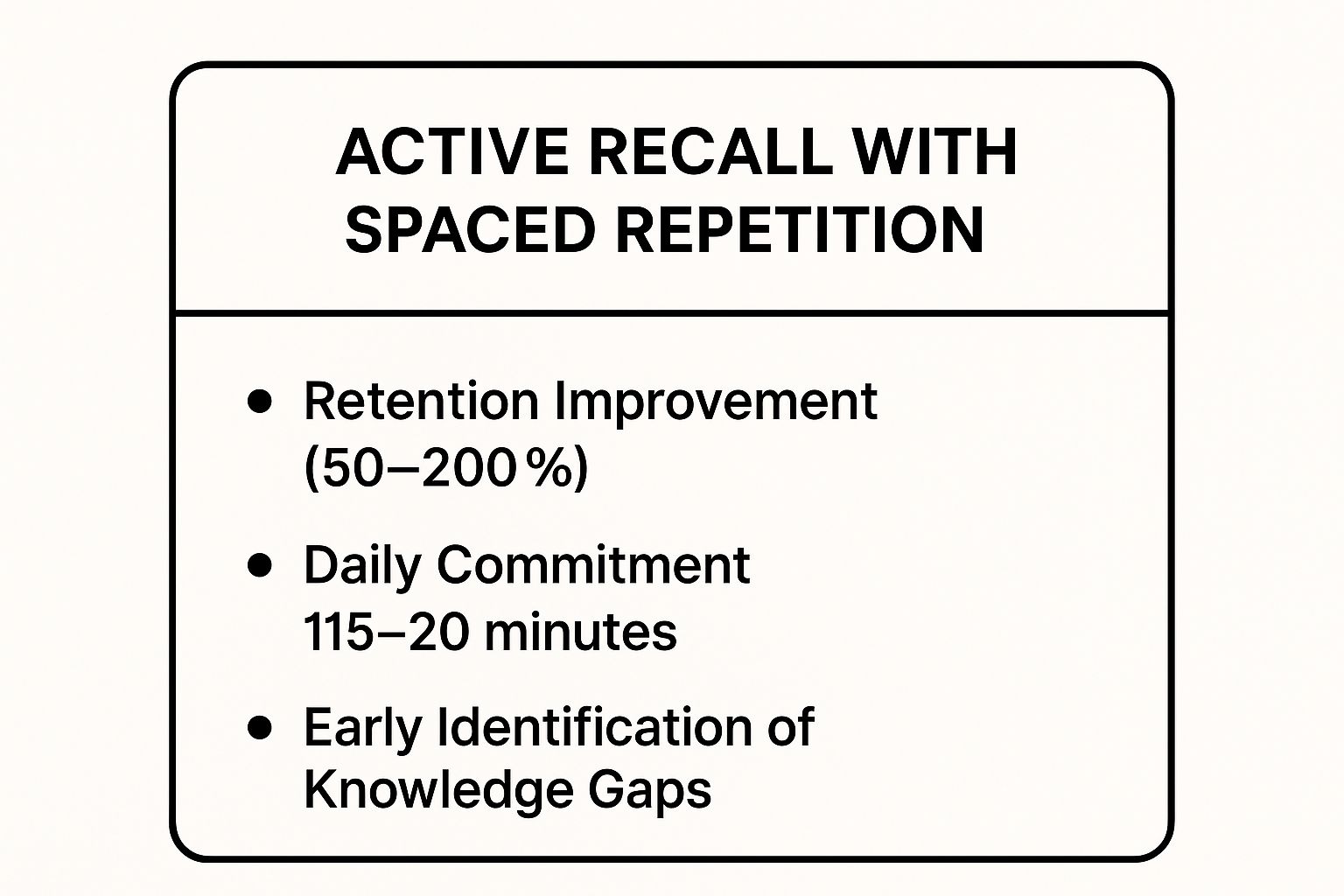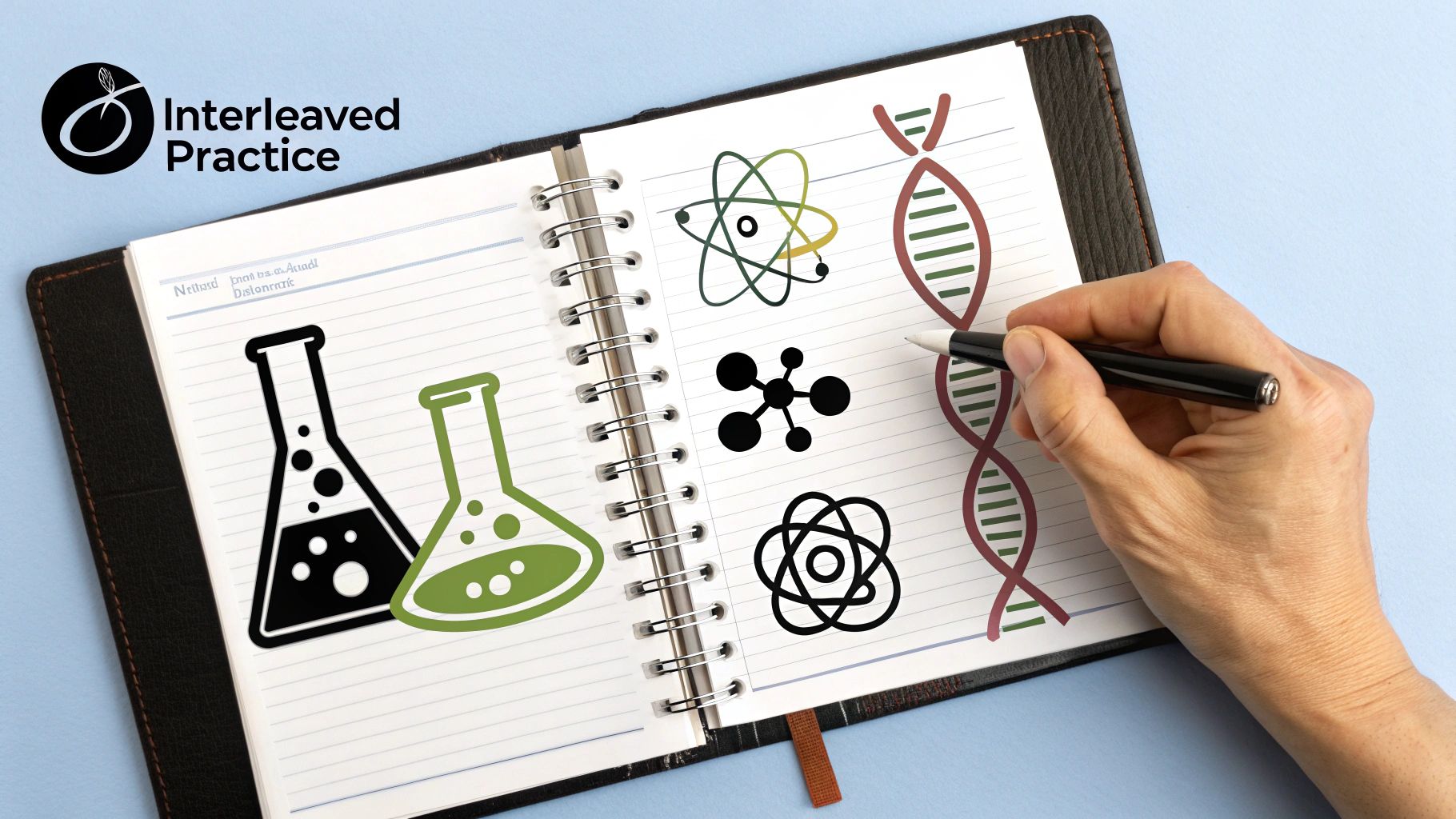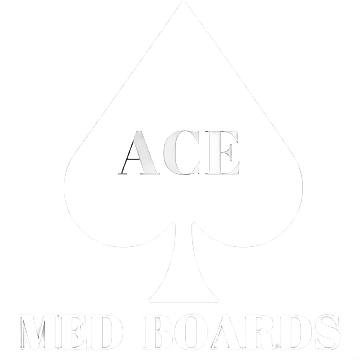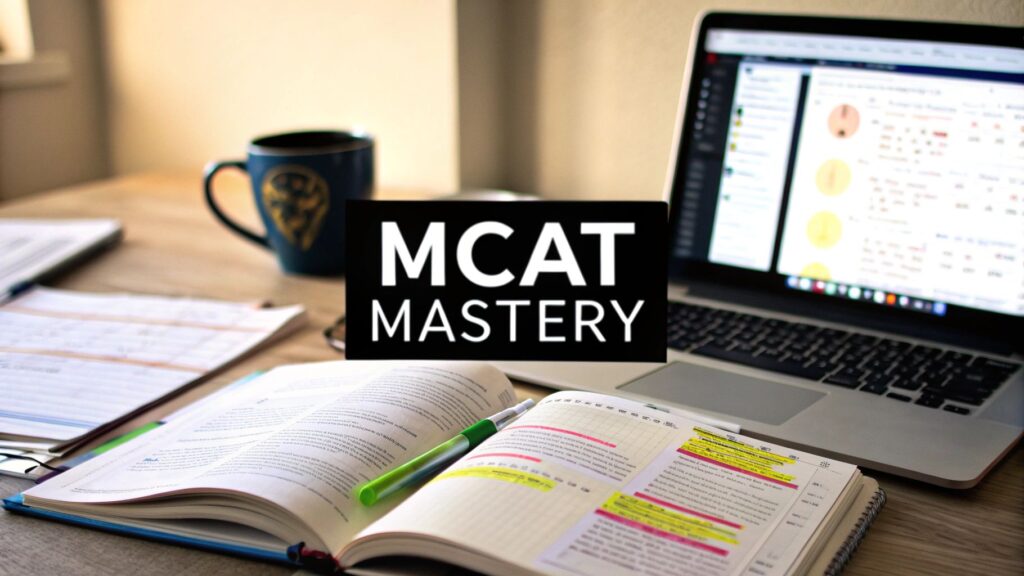The MCAT is more than a test of what you know; it's a marathon of critical thinking, endurance, and strategy. With countless study methods available, finding the most effective approach can feel as daunting as the exam itself. But what if the secret isn't one magic bullet, but a combination of powerful techniques tailored to how you learn best? To truly unlock your MCAT potential and move beyond simple memorization, consider exploring science-backed tips for effective learning. This guide moves beyond generic advice to provide a comprehensive roundup of the 8 most powerful strategies used by top-scoring students.
This article offers a deep dive into the best way to study for the MCAT, focusing on actionable and evidence-based methods. We will dissect each technique, offering clear steps, practical examples, and guidance on how to integrate them into your prep. You will learn how to structure your content review, leverage practice questions for maximum gain, and turn your mistakes into your greatest asset. Whether you have six months or six weeks, this breakdown will help transform your preparation from a stressful grind into a targeted, efficient, and score-boosting journey.
1. Active Recall with Spaced Repetition
Passive learning, like rereading textbooks or rewatching lectures, creates a false sense of familiarity. The best way to study for the MCAT involves a more demanding and effective strategy: actively retrieving information from your brain. This is the core of active recall, a method proven to build stronger, more durable neural connections.
When you combine active recall with spaced repetition, you create a powerhouse study system. Spaced repetition leverages the "spacing effect," a psychological phenomenon showing that we learn more effectively when study sessions are spaced out over time. Instead of cramming, you review information at increasing intervals, right before you're about to forget it. This process interrupts the natural forgetting curve, forcing your brain to work harder to retrieve the information and signaling that it's important to store long-term.
How to Implement Active Recall and Spaced Repetition
The most popular tool for this method is Anki, a free flashcard software that automates the spaced repetition schedule.
- Create Your Own Cards: After studying a concept, immediately create flashcards. For example, after learning about glycolysis, make a card asking, "What are the irreversible enzymes in glycolysis?" This immediate application is key.
- Use Cloze Deletions: For complex processes or definitions, use "cloze" or fill-in-the-blank cards. A card could read: "The Krebs Cycle occurs in the […] of the cell." This tests specific details within a larger context.
- Stay Consistent: Dedicate just 30-60 minutes daily to your Anki reviews. This consistent, low-stakes practice is far more effective than marathon cramming sessions.
This method transforms studying from a passive review into an active, diagnostic process. It pinpoints exactly what you don't know, allowing you to focus your efforts efficiently. The following summary box highlights the measurable impact of committing to this strategy.

As the data shows, even a minimal daily time investment can dramatically boost retention and expose weak areas early. For those interested in a deeper dive, you can learn more about spaced repetition in medical education.
2. Content Review followed by Practice Testing
A foundational and time-tested strategy for MCAT preparation is the phased approach of comprehensive content review followed by intensive practice testing. This method structures your studying into two distinct, sequential blocks. The first phase is dedicated to building a deep, thorough understanding of all the foundational science concepts tested on the exam, from biochemistry to physics. Only after establishing this knowledge base do you transition to the second phase, which focuses on applying that knowledge through rigorous practice questions and full-length exams.
This systematic approach is one of the best ways to study for the MCAT because it prevents you from building test-taking strategies on a weak foundation. By separating content from practice, you ensure you have thoroughly learned the material before facing the complexity of MCAT-style passages and questions. This method is particularly effective for students who have been out of school for a while or those who need to relearn significant portions of the prerequisite science curriculum. It provides a clear, linear path forward, minimizing the feeling of being overwhelmed.
How to Implement Content Review followed by Practice Testing
This strategy is the backbone of many commercial test prep courses, like those from Kaplan and Princeton Review, but can be easily adapted for self-study.
- Set a Hard Deadline: The biggest risk of this method is getting stuck in the content review phase, a phenomenon known as "content paralysis." Set a non-negotiable end date for your content review, typically lasting 2-3 months.
- Use Active Learning: During the content phase, avoid passive reading. Create summary sheets, draw diagrams, and work through end-of-chapter problems. This ensures you are truly internalizing the information.
- Transition with Intention: Once your content deadline hits, shift your focus entirely to practice. Begin with subject-specific question banks (like UWorld) and gradually ramp up to full-length practice exams to build stamina and timing skills.
- Review Your Practice: The practice phase is not just about answering questions; it's about learning from your mistakes. Dedicate as much time to reviewing your practice tests as you did to taking them, analyzing every incorrect and flagged question to identify knowledge gaps.
This structured method ensures that by the time you reach the intensive practice phase, your primary focus can be on mastering the nuances of the MCAT's critical thinking and data interpretation, rather than relearning basic concepts. For a deeper look into structuring this type of study plan, you can explore resources from the AAMC.
3. Interleaved Practice Method
Traditional studying often involves "blocking," where you practice one topic or skill repeatedly before moving to the next. The Interleaved Practice Method turns this on its head by deliberately mixing different types of problems and subjects within a single study session. This approach is a superior way to study for the MCAT because it directly mirrors the exam's integrated, unpredictable nature, where a physics question can follow a biochemistry passage without warning.

Interleaving forces your brain to engage in a process called "discriminative contrast." Instead of mindlessly applying the same formula or concept over and over, you must first identify the type of problem, retrieve the appropriate strategy from your long-term memory, and then execute it. This constant switching strengthens your ability to differentiate between concepts and choose the right tool for the job, a critical skill for succeeding on a multidisciplinary exam like the MCAT.
How to Implement the Interleaved Practice Method
While it may feel more difficult initially, interleaving leads to more robust and flexible learning. You can integrate this technique using practice question banks.
- Create Mixed Sets: Use a question bank (like UWorld or AAMC) to create custom quizzes that pull from multiple subjects. For example, build a 30-question set that includes 10 organic chemistry, 10 physics, and 10 biochemistry problems.
- Alternate CARS Passage Types: When practicing for the CARS section, don't just work through passages of the same style (e.g., all philosophy). Instead, alternate between passages on humanities, social sciences, and natural sciences to practice shifting your analytical framework.
- Start After Foundational Mastery: Interleaving is most effective after you have a solid grasp of the individual topics. Use blocked practice when first learning a concept, then switch to interleaved practice to build mastery and long-term retention.
This method might cause a temporary dip in performance because it’s more cognitively demanding. However, this struggle is a sign of effective learning. Embracing this difficulty is part of what makes this one of the best ways to study for the MCAT, as it prepares you for the reality of test day. For more on the cognitive science behind this, you can explore the work of Robert Bjork and the Bjork Learning and Forgetting Lab.
4. Mistake-Driven Learning
Taking practice exams is standard, but the real growth comes from what you do after the test. Mistake-driven learning is a targeted approach that shifts your focus from simply completing questions to deeply analyzing every single error. This strategy is arguably one of the best ways to study for the MCAT because it forces you to confront and fix your specific knowledge gaps and reasoning flaws, ensuring you don't repeat the same errors.
This method transforms mistakes from failures into valuable data points. Instead of feeling discouraged by a wrong answer, you treat it as a signpost pointing directly to a weakness. By systematically dissecting why you chose the wrong answer and, just as importantly, why the correct answer is right, you build a much stronger and more resilient understanding of the material. This turns passive review into an active, diagnostic process that drives efficient and focused improvement.
How to Implement Mistake-Driven Learning
The key is to create a structured process for analyzing your errors rather than just glancing at the correct answer and moving on.
- Create a Mistake Log: Use a spreadsheet or notebook to track every question you miss. Log the question topic, why you missed it (e.g., content gap, misread question, calculation error), and a brief explanation of the correct logic.
- Categorize Your Errors: Group your mistakes into categories. Are you consistently missing questions about acid-base chemistry? Are you struggling with interpreting graphs in the biological sciences section? This analysis reveals high-yield areas for you to review.
- Dedicate Review Sessions: Schedule specific time slots dedicated solely to reviewing your mistake log. Instead of starting a new topic, spend this time re-learning the concepts behind your recent errors.
This approach ensures that your study time is spent on your weakest areas, providing the highest possible return on your effort. It systematically patches the holes in your knowledge base, which is critical for achieving a top-tier MCAT score. To develop a robust system for this, you can learn more about analyzing your MCAT mistakes.
5. Passage-Based Learning Strategy
The MCAT is not just a content test; it’s a critical thinking and reasoning exam disguised as one. A powerful method to prepare for this format is to shift your focus from isolated facts to learning content directly through MCAT-style passages. This passage-based learning strategy embeds scientific principles within the complex, data-heavy scenarios you will face on test day, building content mastery and test-taking endurance simultaneously.
This approach is one of the best ways to study for the MCAT because it forces you to engage with information exactly as the AAMC presents it. Instead of memorizing the steps of a lab technique, you learn them by analyzing a passage detailing an experiment. This contextual learning trains you to identify hypotheses, interpret data, and draw conclusions under pressure, which are skills that pure content review alone cannot develop.
How to Implement a Passage-Based Learning Strategy
The key is to use practice passages not just for assessment, but as your primary learning tool.
- Use Passages as a Springboard: After completing a passage from an AAMC Question Pack or UWorld, don't just review the answers. Use the passage topic, like enzyme kinetics, as a signal to do a deep dive into that content area.
- Deconstruct the Passage: Actively break down every passage. Identify the main idea, the hypothesis, the experimental setup, and the control groups. Ask yourself why the researchers made certain choices. For success in these sections, mastering critical analysis is key, and improving your overall writing ability can significantly strengthen the fundamental language skills needed for this deconstruction.
- Focus on Question Types: Pay close attention to how questions are framed. Are they asking for a specific detail from the text, an interpretation of a graph, or a conclusion based on the experimental results? Recognizing these patterns is crucial.
This method directly bridges the gap between knowing the content and applying it. By treating every passage as a mini-lesson, you build a practical, integrated knowledge base that is perfectly aligned with the demands of the real exam.
6. Collaborative Study Groups
Studying for the MCAT can often feel isolating, but a well-structured group can transform a solitary grind into a dynamic, collaborative effort. A social learning approach, where students review content, debate difficult concepts, and practice teaching each other, is another best way to study for the MCAT. This method leverages the power of peer accountability and the well-documented benefit of teaching others, known as the protégé effect, which forces you to solidify your own understanding.
By articulating concepts to your peers, you quickly identify gaps in your knowledge. Explaining the function of the sodium-potassium pump or the nuances of a physics formula aloud requires a much deeper level of comprehension than simply reviewing it alone. This process of verbalization and discussion helps to cement information, making it more accessible on test day.
How to Implement Collaborative Study Groups
Effective group study requires more than just meeting up; it demands structure and a shared commitment to a common goal.
- Establish Clear Ground Rules: Before your first session, agree on expectations. Set rules for attendance, preparation, and staying on topic. This prevents sessions from devolving into social gatherings and ensures everyone is equally invested.
- Assign and Teach Topics: Use a "divide and conquer" strategy. Assign a specific high-yield topic, like amino acid structures or acid-base chemistry, to each member for every meeting. Each person is responsible for becoming the "expert" and teaching that topic to the group.
- Focus on Problem-Solving: Center your sessions around practice problems. Work through challenging AAMC or UWorld questions together, discussing different approaches and rationales for both correct and incorrect answers. This simulates the critical thinking required for the MCAT.
This method transforms study sessions into active learning labs. It provides immediate feedback, diverse perspectives on complex problems, and crucial moral support during the long preparation journey.
7. High-Yield Topic Prioritization
The MCAT is a marathon, not a sprint, and trying to master every single detail with equal intensity is a recipe for burnout. The best way to study for the MCAT involves a strategic approach that prioritizes your efforts. This means focusing your study time on high-yield topics, which are the concepts and subjects that the AAMC tests most frequently and heavily. This data-driven method ensures you are investing your limited time where it will have the greatest impact on your score.
By analyzing the official AAMC content outline and patterns from past exams, you can identify which areas offer the best return on investment. For example, concepts like amino acids, foundational biochemistry, and experimental design principles appear consistently across multiple passages and sections. Dedicating extra time to achieve mastery in these areas builds a strong foundation that pays dividends on test day, while treating less common topics as secondary priorities.
How to Implement High-Yield Topic Prioritization
This strategy isn't about ignoring certain subjects, but rather about allocating your study time intelligently. You build a strong core of knowledge that you can rely on for a significant portion of your points.
- Analyze the AAMC Outline: The AAMC provides a detailed content outline. Use this as your primary guide to understand the proportion of questions dedicated to each subject area. Test prep companies often provide helpful breakdowns of this data.
- Prioritize Foundational Concepts: Focus intensely on topics that serve as building blocks for others. For example, mastering thermodynamics in General Chemistry is crucial for understanding metabolic processes in Biochemistry. Similarly, a deep understanding of research methods is vital for the Psychology/Sociology section.
- Don't Completely Ignore Low-Yield Subjects: While you should prioritize, don't neglect less-tested topics entirely. A basic understanding is necessary, as these can still appear as discrete questions or within passages. Cover them after you feel confident in your high-yield knowledge.
This method shifts your focus from "covering everything" to "mastering what matters most." It’s an efficient, targeted approach that maximizes your scoring potential by ensuring you are an expert on the topics most likely to appear. For a comprehensive list of these crucial areas, you can learn more about MCAT high-yield topics.
8. Simulation-Based Practice
Mastering MCAT content is only half the battle; performing under pressure for 7.5 hours is the other. This is where simulation-based practice becomes indispensable. It involves taking full-length practice tests under conditions that meticulously mimic the actual exam day. This intensive method is the best way to study for the MCAT because it builds mental and physical stamina, refines your timing, and demystifies the test-day experience.
This strategy treats each practice exam not as a simple assessment, but as a comprehensive learning opportunity. By simulating everything from the 8 AM start time to the structured break periods, you condition your mind and body for the marathon ahead. This process exposes weaknesses in pacing, focus, and knowledge application that are impossible to identify through content review alone.

How to Implement Simulation-Based Practice
Integrating realistic simulations into your study plan is crucial in the final 2-3 months of your preparation. The AAMC official practice exams are the gold standard for this purpose.
- Replicate Test-Day Conditions: Take your practice test in a quiet location, starting at the same time as your scheduled MCAT. Turn off your phone and use only the allotted break times.
- Focus on Pacing: Use each section to practice your timing strategy. Learn when to move on from a difficult question and how to manage the clock to ensure you attempt every problem.
- Prioritize Thorough Review: The real learning happens after the test. Dedicate 3-5 hours within 48 hours to review every single question, both correct and incorrect. Create a log of your errors to identify patterns in your mistakes.
- Track Your Progress: Monitor your scores across multiple full-length exams. This data will reveal your strengths and highlight the content areas requiring more focused review.
This approach transforms practice tests from passive gauges of knowledge into active training sessions. It builds the resilience and strategic thinking necessary to achieve your peak performance when it truly matters. You can access the official AAMC practice materials directly from their website to get started.
MCAT Study Methods Comparison Table
| Study Method | Implementation Complexity 🔄 | Resource Requirements ⚡ | Expected Outcomes 📊 | Ideal Use Cases 💡 | Key Advantages ⭐ |
|---|---|---|---|---|---|
| Active Recall with Spaced Repetition | Moderate (initial setup, consistent daily practice) | Moderate (flashcards, software like Anki) | High long-term retention (50-200% improvement) | Memorizing large factual content with long-term retention | Efficient study time, confidence building |
| Content Review followed by Practice Testing | High (months of sequential study phases) | High (books, courses, videos) | Strong foundational knowledge | Students needing structured, comprehensive content mastery | Clear milestones and solid understanding |
| Interleaved Practice Method | Moderate to High (mixing topics requires planning) | Moderate (question banks with mixed sets) | Improved problem-solving flexibility | Students with solid knowledge wanting to enhance adaptability | Better transfer between concepts, realistic test prep |
| Mistake-Driven Learning | Moderate (requires detailed error tracking) | Low to Moderate (logs, notes) | Efficient weakness targeting and score improvement | Students seeking to fix mistakes post-content review | High study efficiency, metacognitive gains |
| Passage-Based Learning Strategy | Moderate (access to large passage banks needed) | Moderate (passage packs, analysis tools) | Improved passage analysis and context-based learning | Students with good foundations improving test skills | Builds exam familiarity, critical reading |
| Collaborative Study Groups | Low to Moderate (coordination and focus required) | Low (group members, meeting space) | Enhanced understanding through teaching | Learners who benefit from discussion and peer motivation | Accountability, multiple perspectives |
| High-Yield Topic Prioritization | Low to Moderate (data gathering and study focus) | Low (data/materials on topic frequency) | Maximized score improvement per study hour | Time-constrained students focusing on impactful topics | Efficient use of study time, confidence boost |
| Simulation-Based Practice | High (full-length tests under strict conditions) | High (practice tests, timed environment) | Improved stamina, timing, reduced anxiety | Students refining test-day skills with solid content knowledge | Realistic practice, endurance and timing gains |
Synthesizing Your Strategy for Peak Performance
As you embark on your MCAT preparation, it's crucial to understand that the search for a single "best way to study for mcat" will lead you to a powerful conclusion: success lies in synthesis. The most effective study plans are not monolithic; they are dynamic, personalized mosaics built from the proven strategies we've detailed. Your journey is about more than just memorizing facts; it’s about architecting a system that works for your unique learning style, schedule, and goals.
The strategies discussed, from Active Recall with Spaced Repetition to Simulation-Based Practice, are not isolated options to choose from. Instead, they are interconnected components of a comprehensive preparation engine. Your task is to become the chief engineer of your own study plan, skillfully combining these elements to build momentum and achieve peak performance on test day.
Weaving the Threads: Creating Your Hybrid Approach
Think of your study timeline in phases, with different strategies taking prominence at different times.
- Foundation Phase: This initial stage is dominated by Content Review and High-Yield Prioritization. You are building the essential knowledge base. However, you should immediately integrate Active Recall with Spaced Repetition (using tools like Anki) to ensure this foundational knowledge sticks.
- Application Phase: As you become more comfortable with the content, your focus must shift. This is where Interleaved Practice and Passage-Based Learning become your primary tools. You’ll move from reviewing isolated facts to applying concepts in the context of complex, MCAT-style passages.
- Refinement Phase: The final weeks before your exam are for honing your skills. Simulation-Based Practice (full-length exams under timed conditions) is non-negotiable. Each simulation must be followed by a rigorous session of Mistake-Driven Learning, where you analyze every error to patch knowledge gaps and refine your test-taking strategy.
Throughout this entire process, Collaborative Study Groups can serve as a powerful catalyst, offering new perspectives and accountability. The true "best way to study for mcat" is this fluid integration, a plan that evolves with your growing competence.
The Ultimate Takeaway: From Strategy to Score
Mastering these approaches does more than just prepare you for a test; it fundamentally changes how you learn. The critical thinking, analytical reasoning, and disciplined self-assessment required for the MCAT are the very skills that define an excellent medical student and a competent physician. You are not just studying for an exam; you are training for a career.
This journey is demanding, but by thoughtfully combining these powerful techniques, you build a robust, resilient, and highly effective study plan. You move beyond passively hoping for a good score and start actively engineering one. Embrace the process, trust the strategies, and commit to the disciplined work required to turn your medical school aspirations into reality. Your future patients are counting on it.
Feeling overwhelmed trying to piece together the perfect study plan? Let our experts build it for you. The tutors at Ace Med Boards specialize in creating personalized MCAT prep strategies that integrate these elite methods, providing the one-on-one guidance you need to maximize your score. Visit Ace Med Boards to learn how our tailored approach can unlock your full potential.

